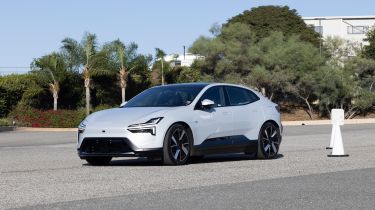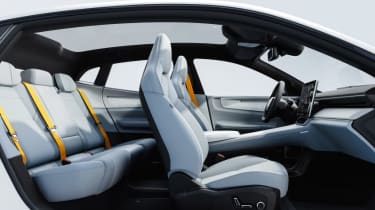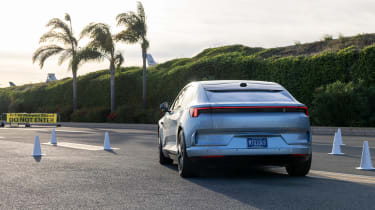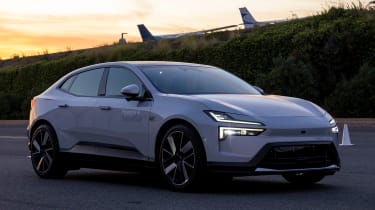Polestar 4 lacks a rear window – our ride proves that doesn’t matter
The Polestar 4 gets a striking design and no rear window – we’ve now ridden in the back of it, and you’re not likely to miss it
- Fastest Polestar model to date
- All-new electric underpinnings
- Advanced autonomous driving technology
The sleek Polestar 4 coupe SUV is nearing production and Volvo’s spin-off electric brand is hoping it will end up being its best-selling model. From its initial reveal, the car’s design has caused quite a stir with its lack of a rear window
We’ve now been able to experience a preproduction Polestar 4 first-hand, and the back seats feel roomier than you might expect. Boot space also seems impressive thanks to its clever packaging – you can read our full first impressions further down in this article.
 Top 10 best sports and performance SUVs 2025
Top 10 best sports and performance SUVs 2025
The 4 is also set to take the crown as Polestar’s fastest car to date – though specifics haven’t yet been confirmed. Confusingly, the Polestar 4 will slot between the Polestar 2 and 3 in the brand’s lineup, rather than above the 3 as the name might suggest.
Polestar is set to debut a slew of advanced driver assistance systems in the new Polestar 4 that bring owners closer to the dream of a self-driving car than ever before. It will get the latest LiDAR sensors from tech partner Luminar, as well as autonomous driving software from Mobileye. The sensors reproduce a 3D model of the car’s surroundings, which Polestar hopes will unlock the potential of autonomous driving, where the driver barely has to provide any input on motorways and where the law allows.
Polestar 4 design
The Polestar 4’s design is inspired by the Polestar Precept Concept. The upcoming Tesla Model Y and Porsche Macan EV rival’s nose dips down dramatically at the front, with slim four-piece LED headlights reminiscent of the Polestar logo, giving a sophisticated, yet minimalist look.
The car’s silhouette tapers off towards the rear, giving a coupe-like look leading down to the trademark Polestar rear light bar. The most controversial part of the design, however, is the absence of a rear windscreen – instead, the Polestar 4 has an opaque, plastic panel mimicking the shape where the rear glass might have gone. It’s another design cue taken from the Precept; the 4 uses a camera to show a rearward view inside the car.
Polestar 4 interior
The fear with the lack of a rear window is that the Polestar 4’s interior might feel claustrophobic, but design director Maximilian Missoni says its absence allows the rear header rail to be pushed further back and give more headroom for the rear occupants, as well as help the car stand out in terms of styling.
In fact, we’ve had a chance to sit in the back of the Polestar 4, and can confirm that the lack of a rear windscreen is actually not that noticeable – the long glass roof still allows the interior to feel light and airy, and that added headroom is very apparent. Knee room and boot space are good as well, so it looks like a clever, innovative package.
Up front, the Polestar 4 gets a 15.4-inch landscape-oriented Google-based infotainment screen. Drivers get a 10.2-inch digital gauge cluster ahead of them, too, and over-the-air updates are intended to keep the car’s media systems fresh. Other than that, the car’s interior is fairly minimalist, as Polestar and sister brand Volvo have become known for.
Polestar has been outspoken about its commitment to sustainability and the Polestar 4 will continue this – there’s a range of materials on offer, including a recycled knitted fabric developed with a textile college based in Sweden, similar to those used on the latest fashion trainers. There will also be a more sustainable leather alternative, but fans of Nappa leather will still be catered for, and this will be ‘welfare-secured’.
Polestar 4 chassis and powertrains
While full drivetrain details are yet to be revealed, the Polestar 4 is the first car to sit on the brand’s latest SEA (Sustainable Experience Architecture) platform. The Polestar 4 can therefore accommodate rear or all-wheel drive configurations, with Long Range versions featuring a 102kWh battery.
All-wheel drive twin-motor models produce 537bhp with an estimated range of up to 350 miles, while single-motor rear-wheel drive models have 268bhp and a range of up to 372 miles. The Polestar 4 will be the brand’s fastest production car with a 0-62mph time of 3.8 seconds (7.4 seconds for the single motor version), though top speed is capped at 124mph on dual-motor cars. Importantly, though, Polestar says comfort has been a bigger priority for the 4 – a welcome development following after the Polestar 2’s ride has been criticised for its harshness.
Charging should also be quick, with 200kW fast charging capability getting the Long Range versions from five to 80% charge in 32 minutes at a compatible charger, and bi-directional charging that allows you to power other items using the car.
The Polestar 4 is set to go on sale in the UK in Spring 2024, likely beating its key Porsche Macan EV rival to market. Pricing is yet to be announced, although Ingenlath stated in 2021 that the Polestar 4 could start from around €45,000. Taking into account significant inflation since then, car buyers can expect the Polestar 4 to start from around £55,000 when it finally goes on sale.
Polestar 4 ride review – Steve Walker
Polestar invited us to Los Angeles for an exclusive ride in the new Polestar 4 so we could get a first-hand look at how the car is shaping up. The model we were shown was the long-range, rear-wheel drive single-motor variant.
The Polestar 4 has been described as a coupe-SUV, but in the metal, it feels like something else entirely, with not much sign of the usual SUV design cues such as rugged off-road styling or a high ride height – in fact, the 4 feels more like a large hatchback than anything else.
One of the Polestar 4’s most striking features is the lack of a rear windscreen, which you might expect to make it feel claustrophobic inside. On the contrary, though – a view of the road behind you is produced thanks to a set of cameras which send it through to a monitor where the rear-view mirror would be.
Sitting in the back, you’d be hard-pressed to notice much of a difference unless you look behind you, with plenty of light provided through the long glass roof. Thanks to the lack of a rear window there’s lots of headroom on offer, too, so it in fact feels more spacious than the average car of this size. Better yet, the rear seats are even able to recline, making it a particularly comfortable space to sit in.
While there are certainly many benefits, there are downsides for the driver, too. Although the view through the video screen allows for good visibility, it can be harder to adjust your eyes than using a conventional mirror. Interestingly, you can turn off the video feed which turns it back into a real mirror, but with no rear window, this merely allows you to keep an eye on rear-seat passengers.
As a whole, the Polestar 4’s interior manages to live up to the manufacturer’s slightly premium image, even though some materials used in this pre-production model are yet to be tweaked. The latest user interface for the infotainment system felt crisper and more responsive, and it was clear that improved user-friendliness has been a priority in development, evidenced by larger easier-to-press on-screen buttons, although some more physical controls would have been preferred.
Elsewhere the Polestar 4’s nice interior design is bolstered by attractive ambient lighting which shines through some of the car’s door lining material, creating a pretty effect, especially in low lighting conditions.
While we’ve long found the brand’s earlier car, the Polestar 2, to have a firm unforgiving ride, early signs based on our experience of the Polestar 4 have shown it to be much improved in this area. What’s most commendable is that our test model was actually fitted with a more conventional suspension setup, not the more advanced adjustable dampers set to be fitted to the all-wheel drive dual-motor model. That means that even entry-level models should hopefully offer a comfortable ride.
On the flipside, the Polestar 4 is set to be the quickest of the brand’s lineup yet, so a supple ride also needs to be balanced with some sporty character. First impressions have shown that the brand has done a good job, as the car felt composed through the bends. Power delivery felt smooth and the car as a whole felt very refined as a passenger, too.
Verdict
It’s early days, but the Polestar 4 is shaping up to be a promising new model. It’s clear the brand has taken on board the criticisms of the Polestar 2’s ride, striking a good balance between sportiness and comfort in the 4. While the absence of a rear window might put people off, our ride has shown it’s hardly missed, and this outside-the-box thinking pays dividends when it comes to offering more interior space for rear passengers. We look forward to driving the Polestar 4 for ourselves, but first impressions from the passenger seat are positive.
Can’t wait for a new plug-in crossover? Check out our list of the top 10 best electric SUVs
Recommended

New Subaru Trailseeker revealed as rugged electric SUV with 375bhp

New Subaru Solterra brings more range, power and polish
Most Popular

Omoda E5 targets rivals: now with zero deposit and APR
Tips & advice

Car dashboard warning lights: what does each symbol mean?

Electric car charging stations: public networks, charger types, apps and maps















